Explore Rome, Paris, and London with this Europe itinerary 2 weeks long and packed full of all the classic sightseeing and cultural highlights from each iconic city!
Part One: 4 Days in Rome
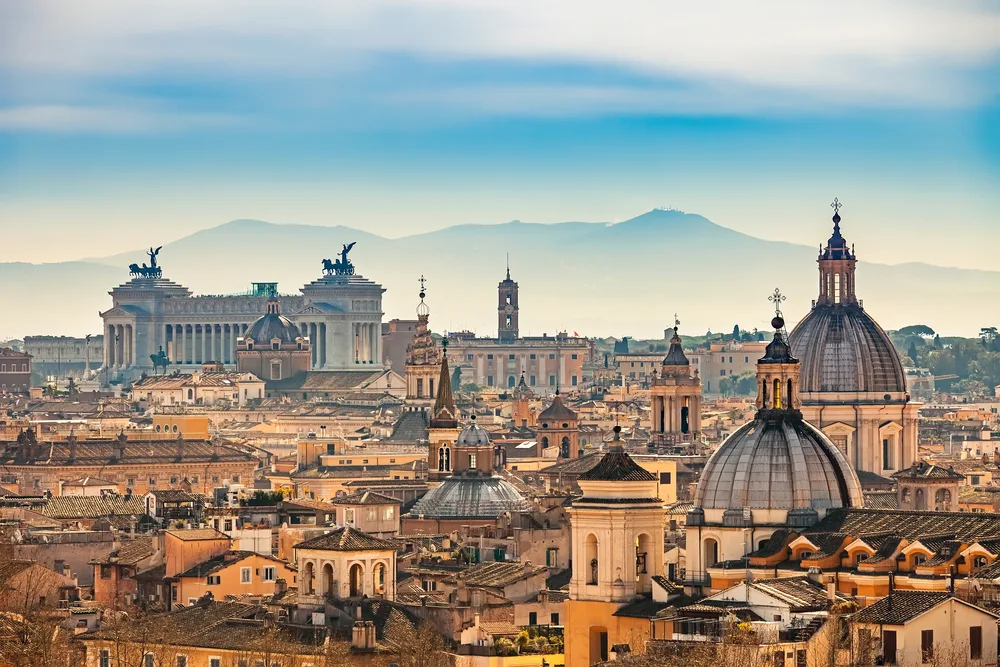
S.Borisov/Shutterstock
The perfect 2-week Europe itinerary starts when you fly to Rome’s Leonardo da Vinci–Fiumicino Airport to begin your trip with 4 blissful days in Rome.
Four days is hardly enough to dive into the deep history and culture of this fascinating city, but it’s just enough to get a balanced taste of what Rome is all about.
Wondering where to stay in Rome? Make camp near the Colosseum at Duca d’Alba Hotel or at the Hotel Diplomatic to be near Vatican City and St. Peter’s Basilica.
Albergo Abruzzi is unbeatable for budget-friendly accommodations right next to the Pantheon. Or go all out and enjoy a luxury stay at Parco dei Principi Grand Hotel near the Villa Borghese!
- Day 1: Vatican City, St. Peter’s Basilica, and Castel Sant’Angelo
- Day 2: Trevi Fountain, the Pantheon, and Piazza Navona
- Day 3: The Colosseum, Roman Forum, and Baths of Caracalla
- Day 4: Appian Way, Catacombs, and Borghese Gallery
Day 1: Vatican City, St. Peter’s Basilica, and Castel Sant’Angelo
Take a taxi to Vatican City from the airport (about 40 minutes) and start the first day of your trip by meandering through this tiny country-within-a-country that serves as the headquarters of the Catholic Church.
Head to the Vatican Museum first. It opens at 9:00AM and the earlier you get there, the better. Pre-book tickets online or with the Omnia Rome and Vatican Pass for convenience and to avoid super-long lines!
You’ll make a full day of it in the Vatican Museum, seeing 7+ kilometers of famous works of art, touring the Sistine Chapel, historic Map Room and Tapestries Hall, and dazzling architectural highlights like the spiral staircase.
Second stop: St. Peter’s Basilica. You’ve seen it in photos, but nothing compares to touring this hallowed ground in person. Join a paid tour to skip the long lines or grab a Rome Tourist Card.
St. Peter’s Basilica is the largest church in the world and filled to the brim with artwork by famed Renaissance names like Raphael, Michelangelo, and Bramante.
Climb Michelangelo’s cupola, or dome, at the end of your tour to be rewarded with absolutely incredible views of the city, St. Peter’s square, and the massive mosaics that line the dome. It’s 231 steps to the top, but you can take the elevator if you’d prefer!
You’ll be hungry after your tour of Vatican City, so stop into the lovely street cafe Ristorante dei Musei for tantalizing Italian dishes like pasta amatriciana in a cozy setting.
Next, head to Castel Sant’Angelo – a 2,000 year old mausoleum-turned-fortress-turned-museum on the Tiber River.
Once the tomb of Emperor Hadrian, you can tour the grounds today with stunning frescoes, sculptures, and artwork that tell its history.
This building has served a litany of purposes, from tomb to military fortress in the Middle Ages, then the Papal Residence to a prison in Renaissance times. As a museum today, you’ll get glimpses of each of these iterations of Castel Sant’Angelo.
Look for the 10 angel statues on the bridge (Bernini’s design from the mid-1600s). At the end of the bridge, statues of St. Paul and St. Peter still stand from their 1624 placement!
Don’t miss the fully-restored shops from the 15th century and the ultimate sight: A jaw-dropping sculpture of the Archangel Michael on the roof of the museum.
End day 1 with dinner at La Fraschetta di Castel Sant’Angelo. Pasta alla gricia is the famous dish and you’ll enjoy crusty bread, wine, and a classic dining atmosphere that’s perfect to end your day.
Day 2: Trevi Fountain, the Pantheon, and Piazza Navona
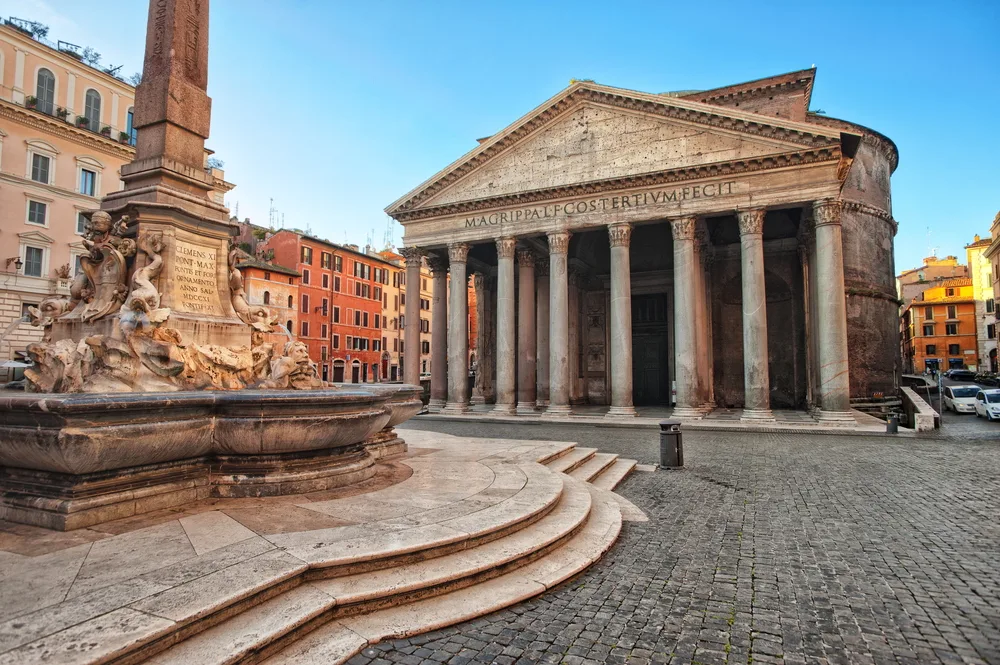
Boris Stroujko/Shutterstock
Set out early in the morning to see the famous Spanish Steps, a 135-step staircase built in the 1730s to connect the Trinita dei Monti stairs with the Spanish Embassy.
Tourists love to stop here and watch people pass by, but you’ll be fined if you sit on the steps. So refrain from taking a seat as you admire the steps!
It’s a short walk to Trevi Fountain from the Spanish Steps. Early morning is the best time to visit the Trevi Fountain since it gets very, very crowded later in the day.
This massive Baroque-style fountain from the 1800s is known around the world. Over 3,000 euros are tossed into the fountain every single day as visitors make wishes to return to Rome.
Snap some photos and head to the Pantheon – a quick walk away and one of the most iconic sights in Rome. This nearly-2,000 year old building is the best-preserved monument from Ancient Roman times.
It was built as a temple to Roman gods and transformed into a Christian church. Kings, famous artists (like Raphael), composers, and architects are buried here.
We recommend taking an audio tour to reinforce your understanding of the Pantheon as you wander through. Buy tickets online in advance.
After you’ve toured the Pantheon, you’ll be near Piazza Navona (5-minute walk). This bustling public space is primarily done in the Baroque style and is truly breath-taking.
The Bernini-designed fountain, Fountain of the Four Rivers, will immediately catch your eye. Built in 1651, it is intricate and detailed in its beauty.
Pop into markets, watch street performers vie for your attention, and check out cute little cafes and bars on the square to satisfy your appetite and get a taste of Rome.
Ai Tre Tartufi is a favorite dining spot with a lovely terrace where you can enjoy great views of the square and people watch as you eat and drink.
Day 3: The Colosseum, Roman Forum, and Baths of Caracalla
Today is a big day on your Roman itinerary! Start with a tour of the ancient ruins of the Colosseum. Once the sight of gladiator battles, today it’s crumbling but a powerful testament to Rome’s distant past.
It’s still the largest amphitheater in the world, even at 2,000 years old. Crowds can be massive here as one of the top sights in Rome, so get here as early as you can.
Pre-book your ticket online or use your tourist pass (Rome Tourist Card or Omnia Rome and Vatican Pass) to skip the long line. Guided tours will also enable you to skip the line.
If you forget to pre-book your ticket to the Colosseum, start at the Roman Forum and get your tickets there (lines are much shorter). Then see the sights in reverse.
The ticket you purchase for the Colosseum also covers the Roman Forum and Palatine Hill with a same-day visit. These sights are directly next to the Colosseum.
The Roman Forum and Palatine Hill are filled with ancient Roman ruins that paint a picture of Rome’s daily life, might, and ability in days of the past.
You’ll see crumbling columns and massive arches, ancient government halls and buildings, and temples built to Roman gods like Saturn.
Once you’ve wandered through the Roman Forum and Palatine Hill, head over to the Santa Maria in Cosmedin church, just 3 minutes away, for a fun experience!
You’ll find the Mouth of Truth, or Bocca del Verita, outside the church entrance. Place your hand inside, but beware: It’s said to bite the hands of liars off! Take a photo to prove your veracity.
Very close by is the Pyramid of Caius Cestius. It’s worth seeing – a big, marbled pyramid standing nearly 40 feet high and built about 2,000 years ago.
It was built as a tomb for Gaius Cestius, an influential and wealthy Roman. It stands just outside of the Protestant cemetery (another cool spot to visit while you’re here).
Just 4 minutes away from the Cosmedin Church are the Baths of Caracalla. Sprawling over 62 acres and open for visitors, this ancient complex once held almost 2,000 people at a time.
Furnaces built in subterranean chambers underneath the baths supplied heat and allowed the workers to move about undetected by guests.
These baths were supplied by the advanced aqueducts the Romans built. It’s truly impressive to see the engineering work and skill of Ancient Rome still standing with mosaic floors today!
Grab a pizza or assortment of delicious Italian pastries from the nearby Il Pane di San Saba bakery. It’s small, authentic, and serves excellent food from breakfast through dinner.
Day 4: Appian Way, Catacombs, and Borghese Gallery
Your final day in Rome is a jam-packed one that takes a macabre turn in the catacombs. You’ll head outside of the city to Appian Way to get started.
Appian Way is one of the world’s oldest and longest roads with much of its original stonework. The initial 10-mile stretch is full of sights and is called the Parco dell’Appia Antica (Appia Antica Park).
You’ll be able to see the Via Latina archaeological area where amazing discoveries have been made over the years and ancient aqueducts that supplied the Roman Empire with fresh water.
Tombs, mausoleums, palaces, and the famous Villa dei Quintili sepulcher filled with amazing sculptures and marble friezes are worth checking out along Appian Way.
But the Catacombs of St. Callixtus and Catacombs of St. Sebastian are truly incredible sights. The Catacombs of St. Callixtus are the burial site of 16 popes and many historic martyrs through time.
You can walk through levels of underground chambers where remains of many of Rome’s first Christians and Catholic leaders were tucked away for centuries.
These labyrinthian passageways tell a fascinating story of the Roman Catholic Church’s beginnings and the Catacombs of St. Callixtus served as the very first official cemetery for the church.
Smaller catacombs, like the Catacombs of Domatilla at the park’s edge and the Catacombs of Pretestato, are also nearby.
Once you’re back above ground, you’ll wander past gorgeous churches and fortresses done in Baroque, Medieval, and Renaissance styles.
Venture to the tomb of Cecilia Metella and the ancient Circus Maxentius just a little further down the Way.
Once you’ve explored the Appian Way, you can head back into the city to get a taste of the Borghese Gallery with its fascinating and historic works of art.
It’s a small gallery, just 2 stories with 20 rooms inside, but the collection quality is impeccable. You’ll see works by Caraveggio, Bernini, and Raphael inside and it’s well worth a visit.
Outside the gallery, stroll through the perfectly-tended Villa Borghese gardens.
When you’re finished, head over to Piazza del Popolo for incredible views of Rome and to grab a bite to eat at the end of your final day.
Consider stopping by Il Porto di Ripetta, a nice little restaurant under brick vaults with a cozy terrace and some of the best seafood and buffet breakfasts in Rome.
Part Two: 4 Days in Paris
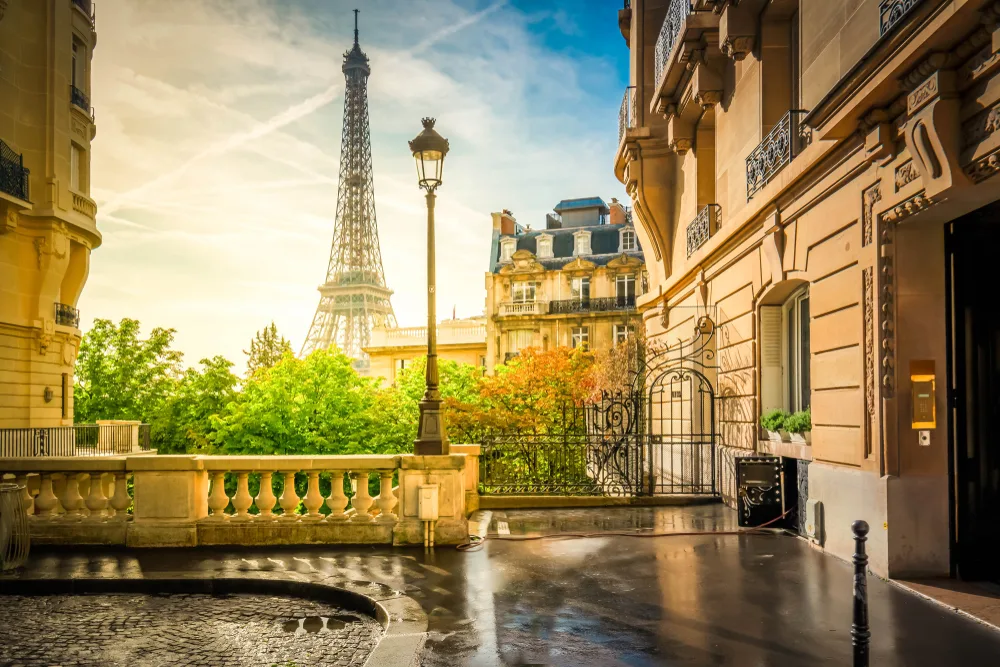
Neirfy/Shutterstock
Fly from Rome to Paris’ Aéroport de Paris-Charles de Gaulle and get ready to experience an entirely different take on Europe, one that’s filled with romance, Gothic architecture, and impressionism.
While 4 days sounds short for a city as famous and historic as Paris, it’s plenty of time to see the main landmarks, museums, and galleries when you have a solid itinerary.
Need to know where to stay in Paris? Stay in the heart of Paris at Hotel du Louvre with close proximity to everything and an onsite restaurant or Villa des Princes in beautiful Saint-Germain.
You could settle into the fun, fashionable Le Marais district for nightlife and stay at the 16th-century Hotel du Vieux Saule. For total luxury close to the Eiffel Tower, only Cler Hotel will do!
- Day 1: Walking Tour, Saint-Germain, and Eiffel Tower
- Day 2: Notre Dame, Sainte-Chapelle, and the Louvre
- Day 3: Right Bank, Champs-Élysées, and Arc de Triomphe
- Day 4: Montmartre, Le Marais, and Rue Montorgueil
Day 1: Walking Tour, Saint-Germain, and Eiffel Tower
A walking or bike tour through Paris is the best way to start your time in Paris while learning about the city, its different arrondissements (districts), and great places to eat and catch nice views.
While you won’t go into most of the stops on a walking tour (like the Louvre), you’ll be able to make a mental note of locations and where you’d like to go later.
TripAdvisor has a great list of walking tours in Paris that can give you ideas of where to start. Free tours can be found, but might not be as in-depth or informative.
After your walking tour, you’ll have seen (though briefly) the main attractions – the Louvre, Eiffel Tower, cathedrals, famous cafes, and more. Head to Saint-Germain next.
Saint-Germain is the 6th arrondissement of Paris and full of great cafes, bakeries, hotels, churches, gardens, and museums.
It’s the perfect place to stop for lunch, a quick gelato (Grom is the best!), or macaron (Maison Mulot).
Stop into shops to grab items for a picnic later at the base of the Eiffel Tower – wine, cheese, sausage, bread, and pastries will be perfect.
You’ll pass by the sprawling gardens of Jardin du Luxembourg (definitely slow down to “smell the roses”) and see the Musée du Luxembourg for a changing array of exhibits.
Check out the Palais du Luxembourg where the Senate meets and admire the frescoes in the beautiful Église Saint-Sulpice church.
You’ll pass the oldest church in Paris, Saint-Germain-des-Près, on your way to the Eiffel Tower in Champs de Mars park.
Once you’re here, enjoy a picnic on the southeastern lawn and head up to the top of the Eiffel Tower to cross another entry off your bucket list.
It’s 1,500+ steps to the top, but you can take an elevator if you’d prefer. Make sure to get tickets online in advance to beat the long lines.
You can cross a bridge over the Seine for even better views of the Eiffel Tower (which you won’t get from the top, though those views are stunning).
Day 2: Notre Dame, Sainte-Chapelle, and the Louvre
What’s a trip to Paris without taking in the holy sights of famous churches like Notre Dame and Sainte-Chapelle? This is an excellent way to start your second day in the city.
Notre Dame was partially destroyed by a blaze in 2019 and the towers and treasury are still closed and under renovation. The parvis, or Notre Dame square, has re-opened along with the archaeological crypt.
Set out early to arrive to a less-crowded Notre Dame square with better photo opportunities. Afterward, you can visit and tour the archaeological crypt under the square.
Head over to Palais de Justice, about a 6 minutes’ walk away, for your next stop of the day.
You’re in for a stained-glass treat at Sainte-Chapelle, which is one of the most beautiful works of architectural art in the city. It’s likely a little smaller than you expected, but truly exquisite.
You’ll need a ticket to enter the chapel and can also purchase an audio guide to learn more about its history. You can purchase tickets onsite or online in advance.
Stop for a bite to eat at nearby Brasserie Les Deux Palais, a favorite spot for locals and tourists alike for classic French dishes in an elegant-yet-casual atmosphere.
Your meal will fuel you up for your tour of the Louvre next! You’ll want to spend as much time as possible walking through the museum.
Give yourself at least 3-4 hours for a full tour and book your tickets in advance or through a guided tour.
Arriving in the slower afternoon helps usher you past crowds and lines if you don’t have a special pass. There’s so much to see here and the museum is absolutely huge, so you need a solid plan or a guided tour.
Guided tours are the best way to experience the Louvre (and understand the significance of what you’re looking at). We recommend booking one if it’s your first time here!
On your list should be the greats of artwork and sculptures, like the Mona Lisa, the Venus de Milo, Winged Victory, Liberty Leading the People, the Coronation of Napoleon, and the French Crown Jewels.
End your packed-full museum tour with a special gourmet dinner at Loulou Paris in the Musée des Arts Décoratifs (Museum of Decorative Arts) in the northwestern wing of the Louvre.
Day 3: Right Bank, Champs-Élysées, and Arc de Triomphe
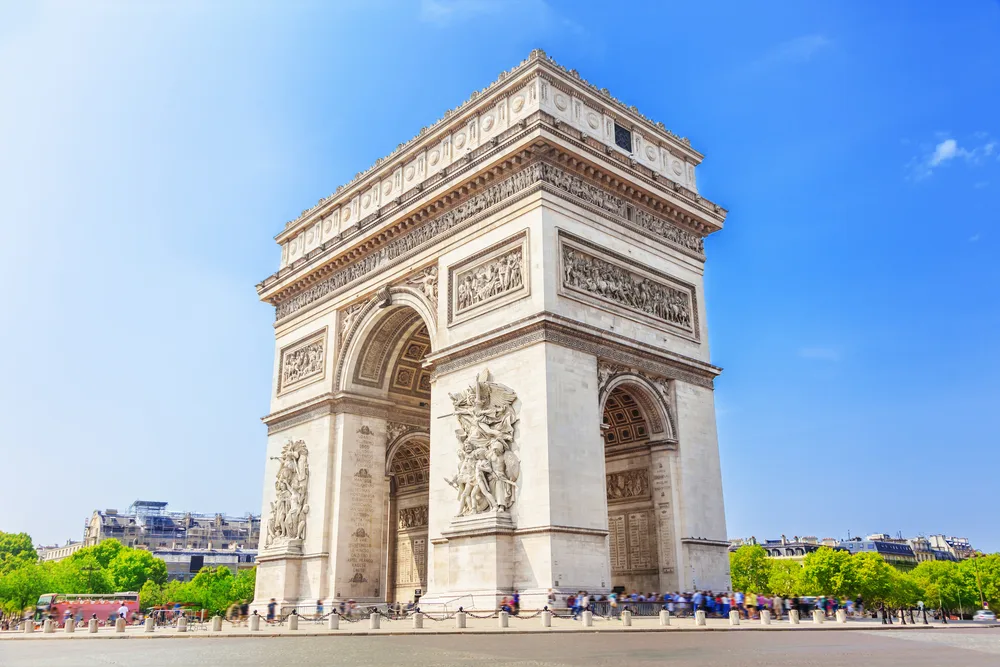
Adisa/Shutterstock
On the Right Bank of the Seine River, you’ll find gorgeous, sprawling gardens that are meticulously maintained and perfect for your viewing (and smelling) pleasure.
Start off at Jardin du Palais Royal surrounding the Royal Palace in the center of Paris. These gardens teem with color and life in the heart of the city and are phenomenal in springtime.
Head to the Jardin des Tuileries (Tuileries Gardens) next, about a 15-minute walk or 10-minute ride away. Locals and tourists wander and lounge in comfortable chairs here by the fountains.
The gardens connect to the Place de la Concorde and culminate in a large square with a towering obelisk over 3,000 years old. This is the perfect spot to sit for a spell!
The Grand Palace, or Grand Palais, is next on your list and is sure to wow you. The palace was built just prior to the 1900 World’s Fair and features a stunning glass roof in the art nouveau style.
You’ll find several exhibits inside if you want to slow down to check them out. Continue on your walk along the Champs-Élysées and you’ll begin to see the Arc de Triomphe come into view.
The Champs-Élysées is filled with adorable shops and stores, so it’s the perfect place to stop in for a treat or a bite to eat.
Find a nice restaurant for lunch and a glass of wine somewhere you can linger awhile at a street cafe with a terrace.
There are countless options along the Champs-Élysées, but if you’re looking for something a bit different than the classic French dishes, try Restaurant LE Drugstore with Asian and American-influenced food.
Napoleon’s Arc de Triomphe appears in its full glory in front of you once you reach the Place de l’Étoile, or Place Charles de Gaulle.
Stop and take in the sight – the way the trees and streets arrange in a stellar pattern and the imposing, victorious arch rises up. Cross the roundabout carefully to get a closer look at the Arc.
You’ll need tickets to go up to the viewing platform, which you can easily buy in advance online to skip the lines.
If you’re up for it, climb the 284 steps to reach the viewing platform and take in views down each of the intersecting boulevards. It’s an incredible view, rivaling what you’ll see from the Eiffel Tower.
If you can time your trip to the top with sunset, you’ll be rewarded with stunning views of the city bathed in golden light. Just after dark, the lights come on and lend a supernatural quality to the city.
Day 4: Montmartre, Le Marais, and Rue Montorgueil
Today is a day to get acquainted with Paris’ unique and charming neighborhoods. It’s amazing how different the vibes are among these areas!
Touring Montmartre, Le Marais, and Rue Montorgueil will give you a balanced sense of what Paris is and a more local, authentic perspective of the City of Light.
Begin your morning in the beautifully picturesque Montmartre neighborhood in the northern 18th arrondissement of Paris. This lovely area will be one of your favorite parts of the city.
Cobblestone streets, quaint cafes, colorful homes and buildings, and famous sights await you in the hilltop neighborhood of Montmartre. It’s quintessential Paris.
Stop by the famous Basilique du Sacré-Cœur, or Basilica of the Sacred Heart, for a tour that offers the most spectacular views of Paris and jaw-dropping architectural details.
Next stop is Le Marais, where you’ll find a slew of boutiques, bars, historic homes, and a huge range of restaurants (many Kosher) in Place des Vosges, along with the best macarons at Carrette.
Walk by #6 Place des Vosges to see Victor Hugo’s former home (author of the Hunchback of Notre Dame and Les Miserables), now a museum.
You’ll find other museums to pop into (including the Musée Picasso Paris) and plenty of old shops filled with antiques at Village Saint-Paul.
Slow down and enjoy the relaxed vibes of Le Marais, stay for the nightlife, or just grab a pastry and coffee on the go!
End your final day in Paris the best way we know: A late afternoon or sunset stroll along Rue Montorgueil. It’s one of the best parts of Paris and so underrated.
Florists, butchers, wine bars, cheese shops, bakeries, mini farmer’s markets staggered along old cobblestone streets – this place feels like the Paris of yesteryear and is a social hub.
You’ll feel enveloped in the heart and soul of Paris on this busy, time-forgotten little street in the 1st and 2nd arrondissements. It’s the perfect way to seal your trip to Paris with a kiss.
Part Three: 4 Days in London

ESB Professional/Shutterstock
Take the Eurostar from Paris to London to begin the final leg of your European tour! London is busy, it’s massive, and it’s packed with opportunities for world-class sightseeing.
London is one of our favorite cities in Europe and its diversity, long-spanning history, and impressive landmarks make it such a treat to visit. That’s why it’s last, but certainly not least!
Not sure where to stay in London? You can’t beat the Z Hotel Soho to be close to nightlife with an onsite bar, while The 29 London puts you close to Westminster and plenty of sights.
Check out NoMad London for close proximity to the British Museum, Convent Garden, and other major sights. Andaz London Liverpool Street is in the heart of the city and an excellent place to stay.
- Day 1: Buckingham Palace, Big Ben, and Westminster Abbey
- Day 2: Famous Markets, Tower Bridge, and Tower of London
- Day 3: St. Paul’s Cathedral, the British Museum, and Soho
- Day 4: Natural History Museum, Kensington Palace, and Saatchi Gallery
Day 1: Buckingham Palace, Big Ben, and Westminster Abbey
When you think of London, Buckingham Palace, Big Ben, and Westminster Abbey are likely landmarks and sights that come to mind. They’re all quite close together and perfect for your first day!
The impressive, historic 775-room Buckingham Palace has been home to Britain’s royal families since the 1830s. It’s your first stop of the day and one that will set the tone for your trip.
You’ll need tickets in advance to avoid very long lines if you come for a tour (available during summer, December, January, and around Easter).
If you don’t go inside, you’ll still be able to marvel at the sheer size and architectural beauty of the palace, which spans over 354 feet wide and nearly 80 feet tall!
Stick around for the Changing the Guard, which happens on Monday, Wednesday, Friday, and Sunday at 10:45AM. It’s free to watch.
Buckingham Palace Garden (the largest in London) and The Queen’s Gallery with portraits and treasures from the Royal Collection are on your way, too.
Take a short walk through St. James’ Park – a great place to stop and admire the lake, fountain, and grab a coffee or tea at St. James’ Cafe. You may see resident pelicans and soldiers marching through the royal park!
Continue on to the Churchill War Rooms, where you’ll find amazing World War II memorabilia and learn about the underground chambers that Winston Churchill lived in at the time.
You’ll be close to 750-year old Westminster Abbey next, where you’ll find breath-taking architectural work and intricate details adorning the church’s hallowed halls.
Head inside to see Westminster Abbey from a new perspective by arranging for a 90-minute guided tour when you book your tickets in advance online.
The Palace of Westminster is just to the east, near the banks of the River Thames, if you’re up for another incredible sight on your way to Big Ben.
You can walk up to Big Ben from here and see the famous clocktower for yourself. You can even climb to the top (399 steps up)! Across the river, you’ll see the London Eye ferris wheel.
Day 2: Famous Markets, Tower Bridge, and Tower of London
After a first day filled to the brim, you’ll enjoy taking a slower pace on day 2 by starting at the famous and historic Borough Market. It’s a foodie paradise!
You’ll find stall after stall of every kind of sweet and savory food and snack you can imagine with all types of delicious, international flavors. Cafes, street food, pubs, and produce abound here.
It’s the perfect place to start your day before heading out to the iconic Tower Bridge, over 800 feet long and designed with incredible attention to detail in the Revival Gothic style.
Cross the bridge by walking to stop at some of the lookout points along the way, getting amazing views of the sprawling city as you go. The glass “floor” is absolutely thrilling or chilling, depending on how you look at it!
Once you cross the bridge, continue on and look to your left to see Traitor’s Gate – the medieval waterfront entrance for treasonous prisoners to the infamous Tower of London.
You’ll need tickets to get into the Tower of London castle (and definitely need to purchase them in advance online to skip the line). Inside, the Crown Jewels and other priceless possessions are securely guarded.
It was once a high-security prison and site of torture for many unfortunate criminals and spies in Britain’s past. Walk the grounds, tour the Tower, and be sure to wander though the museum.
Stop by the Tower Bridge Piazza as you leave for great views of the Tower Bridge and Tower of London and moat. Continuing on, you’ll see the London Wall ruins built by Romans in AD 200.
Head over to Leadenhall Market to refuel with tasty bites and sips from restaurants, cafes, and bars in a covered Victorian market that’s been running since 1321!
This cobblestone-street market is where many scenes of Diagon Alley from Harry Potter movies were filmed. The history and vast variety of food, wares, and bars here makes it a great place to end your day.
Day 3: St. Paul’s Cathedral, the British Museum, and Soho

Janis Lacis/Shutterstock
You’ll be visiting St. Paul’s Cathedral first today, whether you want to admire the architecture from outside or grab tickets in advance for a more in-depth tour of the cathedral.
If you really want to make it memorable, go inside so you can head up to the dome! You’ll appreciate the stunning views from the top of the dome, which look out over London’s landmarks and streets.
It’s free to enter, but you’ll always need tickets to go inside. So don’t delay and grab those in advance to avoid waiting in long lines!
Speaking of getting tickets in advance, you’ll want to grab yours for the British Museum ahead of time, too.
This is a place so full of memorabilia and history that you can easily spend an entire day if you’re so inclined. A guided tour makes it easy to hit all the highlights without investing too much of your short 4-day trip.
This museum houses art, artifacts, and cultural memorabilia items numbering over 8 million. Humanity’s story from the beginning to modern day is told in its collections.
Once you’ve wrapped up your tour of the British Museum, it’s time to head to Soho in the West End (2 minutes away by metro) for a fun-filled night with shopping, eating, drinking, and dancing!
Dine in style at the popular Gauthier Soho (pricey, but worth it!) or try international dishes street-food style along Kingly Court.
Soho’s shops are plentiful, especially in the Carnaby area (boutique and big names). Spend time poking through the shops before you settle into a bar, club, or late-night coffee shop for a few hours!
Bar Soho, Soho Residence, The Spice of Life, 100 Club, and cool jazz spots like Ronnie Scott’s present great opportunities to let loose after sundown.
Along Old Compton Street, London’s thriving LGBTQ+ community has a slew of bars and clubs pumping dance music through the night.
Day 4: Natural History Museum, Kensington Palace, and Saatchi Gallery
Kensington Palace doesn’t quite compare to Buckingham, but it’s absolutely lovely and serves as the home of the Prince and Princess of Wales.
For your royal tour, you’ll need tickets in advance to avoid long lines. The palace is a real residence with exhibits for visitors and only open through certain periods of the year (usually closed in late fall and winter).
Beyond the palace itself, you can tour the Kensington Gardens, the sunken Princess Diana Memorial Fountain, and the uniquely-designed Serpentine Gallery to see artwork created by international artists.
Stop by Da Mario Kensington Italian restaurant at the park’s edge for an amazing thin-crust pizza while dining in a gorgeous Venetian-Gothic style building.
If you didn’t get your fill of museum wandering yesterday, you’ll be able to do so today at London’s Natural History Museum in the South Kensington area!
Dinosaurs, humans, animals, and natural history are brought to life (sometimes with animatronics that kids will love!) in this top-rated museum. Wander through with a guide for the most informative experience.
Finish up at the Saatchi Gallery, an art gallery housed in the former home of the Duke of York in the 19th century. You’ll find contemporary works from well-known and new artists.
When you’re ready for something to eat and a pint or two, head to The Cadogan Arms pub about 6 minutes away.
It’s a traditional wood-interior pub with stag antlers and pub favorites like fish and chips and beef and Guinness pie – the perfect way to cap off your London trip.
Things to Consider
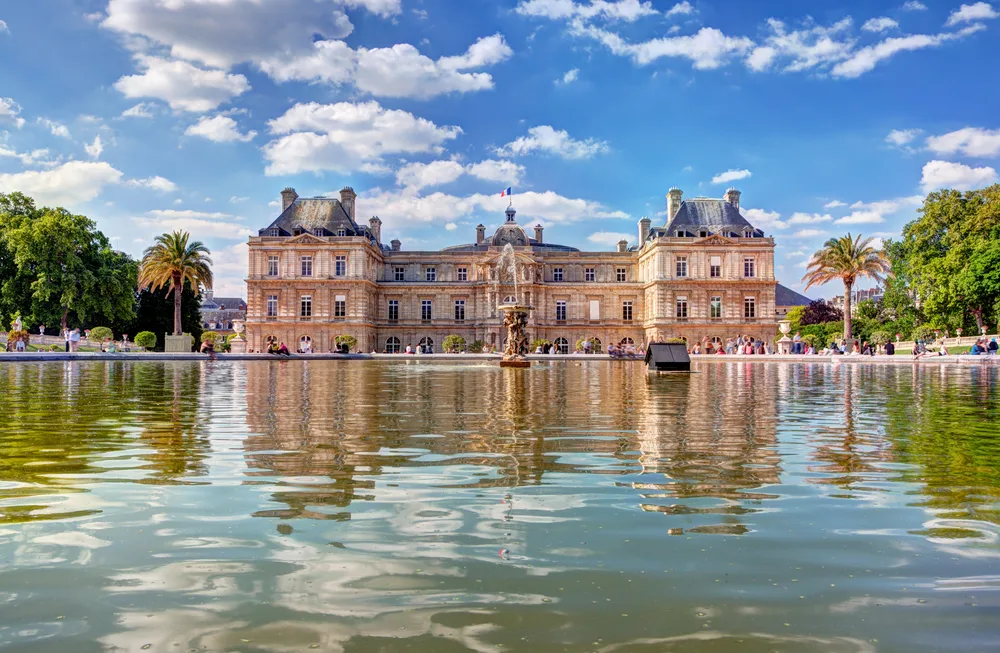
PHOTOCREO Michal Bednarek/Shutterstock
Every Europe itinerary 2 weeks+ runs a little smoother when you have some seasoned traveler tips to help you on your way!
Here’s what you need to know about planning and pulling off a 2-week trip to Europe seamlessly.
- Don’t start your trip on a Sunday. Vatican City and its churches, museums, and galleries are usually closed on Sundays (except for the last Sunday of each month). Make sure you plan your Europe itinerary 2 weeks to start on a day other than Sunday so you don’t miss this fascinating part of the trip!
- Grab tourist passes to skip the line. You’ll have a much smoother trip if you go ahead and determine which passes and cards will be a good value for your Europe trip. These passes give you attraction ticket discounts and enable you to skip long lines. The Omnia Rome and Vatican City Pass is around 150 euros and gives you 3 full days of access in Rome. A 4-day Paris Pass is about 200 euros and includes all the major attractions, while the 4-day London Pass is around 134 euros.
- Figure out public transportation. Public transportation makes getting around European cities much cheaper and easier. It’s the best way to get around on your trip, so studying the maps and stops will help you immensely. London, especially, is well-connected with the underground train system and much easier to explore on the “tube.”
- Invest in an Oyster Card. In London, a visitor Oyster card lets you preload credits to use on the public transit system at a discounted price. It’s well worth the 5-pound cost if you’ll be there for 4 days! We recommend loading about 30 pounds for this Europe itinerary 2 weeks long with 4 days in London. The card will be delivered to your home before you leave for your trip.
- Give yourself time to acclimate to the time zones. Jet lag is real, friends, and it will completely sap you of your energy if you don’t leave yourself with some time to chill and acclimate to the new time zone when you arrive in Rome. Depending on where you’re coming from, the time could be 6-9 hours different. In New York, your 6PM is Rome’s midnight the next day and in L.A., your 3PM is Rome’s midnight!
Frequently Asked Questions
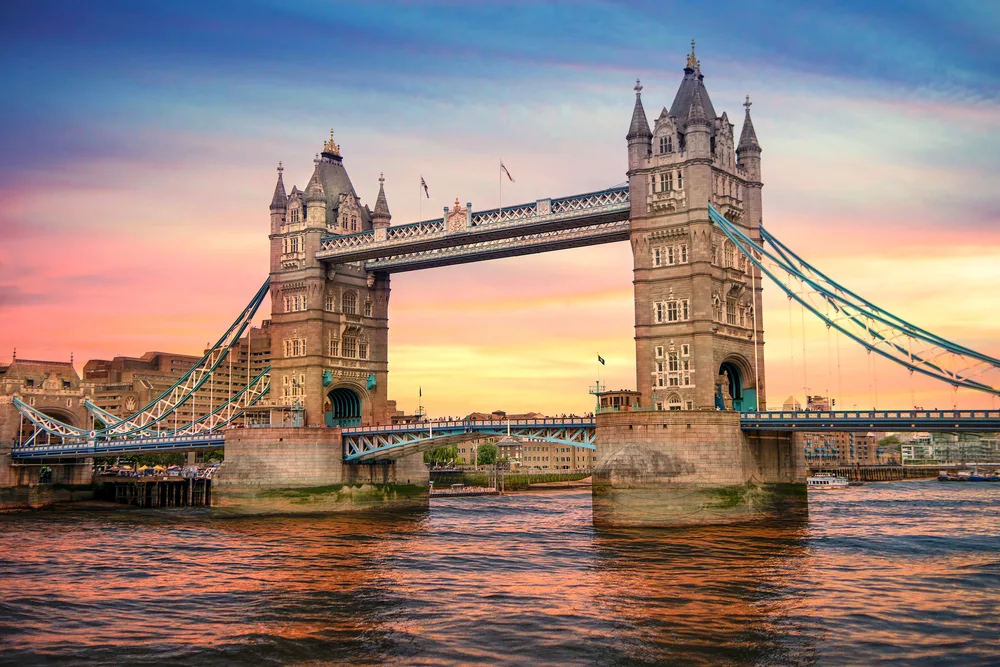
Altug Galip/Shutterstock
Planning a Europe itinerary 2 weeks or more takes a lot of research and a clear understanding of what you want to see, spend, and do while you’re there.
Take these FAQs into consideration as you work toward planning your trip!
How many European countries can I visit in 2 weeks?
You can visit 4-5 European countries in 2 weeks, but you’ll only have a day or two to spend in each. The best way to handle a Europe itinerary 2 weeks long is focusing your visit on 2-3 cities you’re most interested in.
For example, the classic Rome-Paris-London itinerary can easily be done in 2 weeks by allowing 4 days in each iconic city. You’ll see all the highlights without paying for a longer trip than needed.
How much does a 2 week trip to Europe cost per person?
The average 2 week trip to Europe costs about $3,600 per person, with round trip flights around $750-$800 and accommodations running about $900 per person over 14 days.
Your 2-week trip to Europe can be cheaper if you book budget hotels and use strategies to find cheaper flights. Sticking to affordable food options and public transportation will also save you money on a European trip.
Is $10,000 enough for 2 weeks in Europe?
Absolutely, $10,000 is enough for 2 weeks in Europe as long as you’re mindful of your budget and don’t go overboard on food, entertainment, or hotel expenses while you’re there.
Most trips to Europe cost around $3,600 for a 14-day stay. The cities you visit will affect your overall expenses, but $10K should be plenty to finance a 2-week European trip to the most popular countries.
You can stretch it even further in Eastern European countries.
How long should you do a Europe trip?
A Europe trip can be as short as week in 1-2 destinations or as long as a month or more, but a 2-week trip to Europe seems to be the best option for most travelers. This gives you time to explore 2-3 major cities without feeling rushed.
Choose a longer trip to Europe if you want to see more than 3 cities or if you’re serious about diving deep into the sights, history, and culture of your destinations.
Is 14 days enough for Europe?
In most cases, 14 days is enough to visit Europe if you’re interested in exploring 2-3 cities overall. It won’t be long enough if you want to see a little of every country in Europe - you’ll need a month or more for that.
So, What’s the Best 2-Week Europe Itinerary?
Rome to Paris to London – it’s the best 2-week European itinerary there is and it’s a total classic.
If you want to experience the true, beating heart of Europe, this is the itinerary to follow. Take just 4 days in each iconic city to explore, eat, drink, and learn.
You’ll be amazed at how full your trip feels with experiences and memories when your 2 weeks wraps up!
Europe can easily demand a month or more of your time, but if you want to see it all quick and dirty, this 2-week plan to all the highlights in the most well-known cities is perfect for you.



